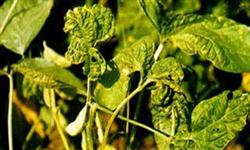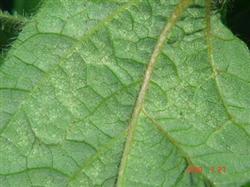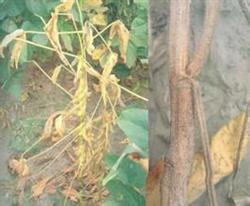Prevention and control of soybean top blight

Soybean top blight, also known as bud blight, is one of the soybean virus diseases that have a great impact on yield. Due to different periods of onset, the loss caused was 25% to 100%. Similar symptoms occurred in foreign varieties introduced in Shandong Province in 1962, and then occurred in Hebei, Beijing, Liaoning, Jilin, Heilongjiang and other places. The disease is caused by a variety of viruses, but the pathogen has not been formally identified, so the pathogen of top blight may be different from place to place. 1. Disease symptoms: most soybean varieties showed no obvious symptoms at seedling stage, only a few rusty spots appeared on the leaves. Typical symptoms appear after flowering, the top of the diseased plant stem bends downward into a hook, the tip of the tender leaves, buds and stems turn brown, dry and easy to fall off, and the pith also turns brown. The necrotic part spread downward. There are brown necrotic stripes on the petiole and irregular brown necrotic spots on the pods, and the leaves often show no symptoms. The plants with early onset were obviously dwarfed, without pods or few pods, and some were unbranched. In addition, the diseased plants can also appear dwarfing, flower buds and compound leaves, node expansion, abnormal dark green leaves, green and dark green in the harvest season, and the seeds of the diseased plants look normal and do not produce brown spots. 2. Incidence regularity: the occurrence and prevalence of top blight vary greatly between years and regions, but the epidemic rule has not been fully understood. The investigation shows that the disease of soybean near perennial forage and wasteland is early and severe, while that of soybean fields adjacent to non-host crops such as corn is late and light. Soybeans can be susceptible to disease at any growth stage, and the disease rate is high before flowering. Most soybean virus diseases can be transmitted by seeds with virus, but it is difficult to detoxify seeds with virus, and it is ineffective to treat seeds with chemicals or grow point culture. 3. Prevention and control methods: ① strengthens quarantine to prevent the spread of diseases. ② selected disease-resistant varieties and adopted avirulent seeds. ③ control of aphids can reduce the damage of virus diseases, spraying 2.5% EC at seedling stage, or using 3% furan powder 2 kg mixed with 15 kg of moist fine soil per mu for sowing, and controlling grubs and cyst nematodes. Intercropping of ④ soybean with long-stalk crops, early sowing at the right time and removal of weeds in the field can reduce the disease.
- Prev

Occurrence and Control of Soybean Red Spider
Red spider is a general term for red spider mites, which is a composite population of several species of spider mites and belongs to the spider mite family. In Huachuan County, it occurs in different degrees every year, but it belongs to light occurrence year. However, according to this year's survey, due to the recent high temperature and drought, the damage of red spiders to soybeans in Huachuan County has risen from a secondary position to a major one.
- Next

Occurrence and control of soybean blight
Soybean blight is commonly known as "dead tree", "quenching" and "black root disease". In years with serious disease, the rate of plant death in lightly diseased fields was 5% to 10%, and that in seriously diseased fields was more than 30%. Individual fields even died out, resulting in no yield. 1. The symptom of soybean blight in the field occurred only in the seedling stage, and the main roots of seedlings and young plants.
Related
- The first cup of black tea in spring, the flavor and history of tea gardens in Kenya, Africa
- The computer can not only choose potatoes, but also grow tea rice. AI will grow winter oolong tea champion.
- It is not only the inflated tea bitten by insects, but also engraved with the four seasons tea in Beipu.
- The Oriental Beauty Tea Festival in Zhuxian County takes the stage at the weekend to experience the plus-size feast of oil tea.
- & quot; Oriental Beauty Tea & Exploration of Emei in Hsinchu, the hometown of quot;
- The new variety of strawberry "Tainong 1" dessert is the first choice with mellow aroma. Crimson gorgeous
- History of Tea in Taiwan: from Wild Inner Mountain to Export Tea Garden
- Two types of Taiwan Oriental Beauty Black Tea won the British three-Star Award for Childhood Tea Xiang Zhang Jiaqi changed from pilot to champion tea maker.
- Banana species and varieties: the planting history of Taiwan Xianren banana and dwarf banana is long, is banana disease resistant?
- Coffee planting Technology: Qianjie Coffee from Seedling to harvesting

